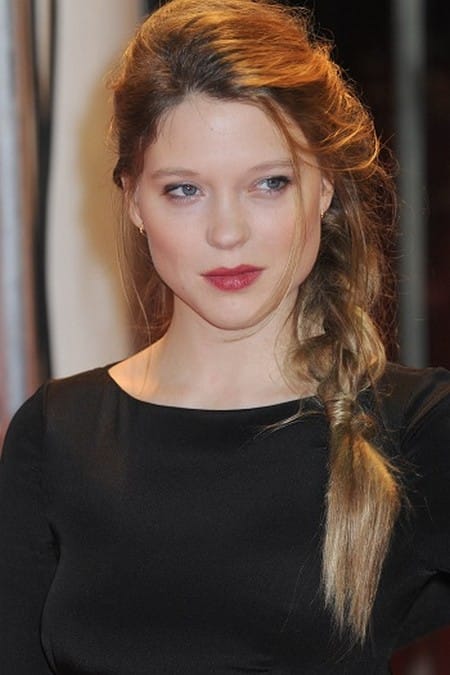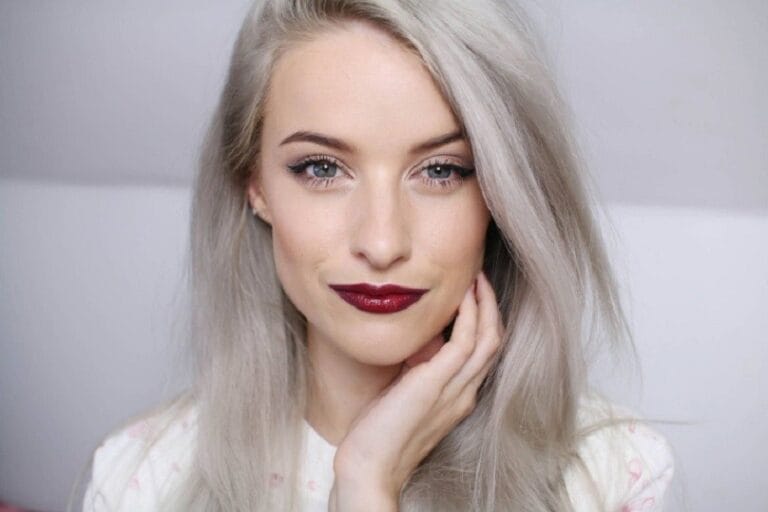What cut, hairstyle, and length look best on a round face? What are the facial characteristics of the round face and how do you highlight them? The questions I answer in this article bring together the opinions of hairdressers and all their best advice for adapting your hairstyle to your face shape and harmoniously balancing the volumes. The case of curly hair, but also fine hair, is also discussed
Recognizing a round face: the characteristics of a round face (measurement and proportions)

A round face is an approximately equal distance between your chin and the top of your forehead and between your ears (or between your two cheekbones).
In summary: a round face is about as wide as it is long, or with a width equal to more than 2/3 of its length. The size of the forehead and the distance between the cheekbones and the jaw are also equivalent.
In addition, the face has soft curves, notably a round chin and hairline (no angular features), and the cheeks are often full (this is what differentiates it from a square-shaped face in particular).
The widest area is on the part of the cheeks going from the entrance to the ear to the other. The width of the cheeks is greater than the brow bones and the maxillary bone. The neck is quite often also wide.
These faces, nicknamed baby faces, are often compared to those of a doll because of their tender and youthful features. perhaps Brigitte Bardot is the icon of the genre.
NB: Identification of the shape of the face is based on a neutral and relaxed facial expression (no smiling or muscle contraction), with the hair pulled back
Type of cut that highlights and refines the round face
General principles: cuts that work on a round face
A successful cut and hairstyle for a round face aims to create an illusion of length. while refining its curves to bring it closer to the ideal oval shape (ovalization).
The right gradient for round faces: a blurred and textured cut
To lengthen and refine a round face, we favor long or mid-length layered cuts, which give verticality, while framing the face. The uniform length of hair does not suit round faces. It is advisable to opt for long locks gradually layered with transitions that blend into each other very smoothly. This effect is obtained by spiking their tips for a blurred and tapered appearance to reduce the roundness of the face while avoiding a pyramidal effect.
The gradient on short locks elongates the faceless and tends to create volume; on the contrary, it must be removed (not to mention that this can give a somewhat “grandma” style)… The shortest lock should never be stopped higher than the earlobe or even lower.
Likewise, soft waves will distract attention from the facial roundness, and prevent the hair from following the round shape of the facial contour.
To counterbalance the weight of long hair, shorter sections can be cut in the vertex and plateau area (top of the head) to create volume at height. Strands can also be layered downward from the cheekbones to create an interesting angle that will bring out the bone structure of the face.
Two schools stand out: hairdressers who advise creating as many angles as possible with the cut to structure the face and others who believe that it is better to cultivate soft, round curves. It’s up to you to choose based on your personal preferences (I vote for the second option)!

Correctly place the volume of the hairstyle on a round face
Everyone nevertheless agrees that the volume must be placed high (at the level of the plateau, the vertex, and the bangs) on a round face and be limited on the sides (with short locks or a fall as close as possible). as possible of the face) on the facial periphery. This shape of cut is sometimes compared to that of a diamond.
This means that it is the top of the hair that must be layered to gain fullness at this level. For curls, this means that they are welcome on the upper part (plate and vertex) but reduced near the cheeks.
Objective: draw the eye to the mouth and eyes and not the thickness of the hair. In general, it is recommended to grade the bottom lengths well to reduce the mass in the neck and therefore the face. The cut must, in all cases remain blurred and not at a sharp angle.
Some hairdressers also advise always keeping longer strands in the hairstyle that will fall on the face to refine the contours of the face and structure the cheekbones (a rule, however, that others encourage breaking with hairstyles pulled back; see here below). The ends follow a movement towards the cheeks.
Interesting tip: bring down the widest part of the hairstyle/cut at the points delimiting the wider area of the face (eg: the cheekbones). This is how the first level of the gradient must also fall under the widest part as well.

Create asymmetry to refine a round face
Asymmetrical or diagonal cuts are also good choices, especially when playing with uneven lengths.
A long plunging bob (possibly with a ball effect at the back falling below the jaw is also a good option (except for curly hair). Generally speaking, round faces like blurred, wrinkled, and textured styles with soft movements. We also play with side hairstyles (fuzzy bun, spiky braid, or ponytail) or low-side partings.
See article: Tie up your curly hair: a stylish low-side ponytail! (“one shoulder”)”
What cuts/hairstyles should you avoid for a round face?
Among the enemies of the round face are:
- Straight and clean cuts of equal length, like the classic bob, without texture or relief,
- Short bobs above the jaw (on the other hand, certain shortcuts can still be suitable according to certain principles, see below),
- Short, curly hair is also not recommended,
- Long straight “drumstick” hair with a parting in the middle,
- The perfectly symmetrical parting in the middle,
- The bob square, with the volume on the side of the face which enlarges the cheeks and which follows their round shape, at the height of the chin,
- in general, the volume on the sides from the ears (which delimits the widest part of the face, which we do not want to widen further)
- Straight bangs with a clean-cut
- Bowl cuts,
- Cuts with a round shape in general, particularly those that end at the chin,
- Hairstyles that are too strict or geometric,
- Low attachments,
- straight, flat hair without movement along the face,

- Thick, horizontal bangs that make the forehead smaller,
- Hairstyles that are too voluminous on the lengths, very curly and heavy, which thicken the features,
- Very large curls on the lengths, which increase the volume on the lower part of the face,
- Very long curtain-style hair that weighs down the face,
- Boyish cuts without length.
Please note that these are general rules which may always include exceptions…
Is a bob cut suitable for round faces?
As indicated above, classic squares with a uniform and symmetrical straight cut are usually to be avoided for a round face whose roundness they accentuate. On the other hand, a gradient square (see above) is a good option!

Long or short hair: the best length for a round face?
Generally, long (shoulder length) or mid-length (base of neck) hair is recommended for round faces because the length tends to elongate the face. However, if the hair is too voluminous or excessively long (“curtain”), it can weigh down the face.
The bottom of the hair, under the chin, will be a little more voluminous (texturization, curls, etc.).
To avoid: a cut that stops at the height of the chin or jawbones (especially if you have a short neck). The ideal length should fall at least a few centimeters below the chin.

The importance of neck size and lengthening to slim the neck
In the case of a small neck, a cut that falls approximately 2.5 cm below the shoulder will create a length effect, highlighting a round face, leaving space between the hair and the shoulders, and giving the impression of a more slender neck (if the lengths are not too thick).
Short hair and round face
Short cuts above the chin and jawbones should be carried out with caution on a round face because they often risk widening the lateral areas of the face (cheeks and cheekbones).
However, they can adapt to round faces as long as they maintain length and volume on the top of the head, above the forehead, with typically a light asymmetrical “headband” section sweeping across the forehead.
The asymmetrical principle of a short nape with longer frontal locks works well too. Without always forgetting to work highlights to give texture and dynamism to the cut and tapered ends. On the other hand, you must take care to keep the sides of the face smooth or short enough so as not to add fullness at this strategic level. A few strands fall on the cheeks to reduce curves.

The general principle: the upper locks (above the ears) should be longer than the locks near the ears and along the cheeks). Ears must be covered.
We also avoid straight locks with a flat fall, and we opt for a gradient, which adds texture. It is typically the feminized boyish cut (called “pixie”) where longer locks at the level of the ears sit on a short base, an asymmetry which allows to maintain softness.
A shortcut has the advantage of providing lightness and pep to round faces.
Which part should I choose for a round face?
The most popular parting for a round face remains the low or asymmetrical side parting. The reason? It contrasts with the roundness of the features by creating angles (the cut must adjust to this choice of parting to have locks of the right length on both sides).
A very low side parting that cuts the face in three-quarters creates the illusion of a more oval face, especially if you have the volume up top. This type of parting will distract attention from the symmetrical circularity of the face. Wear hair-free or tied up high.

Middle parting and round face
We often read/hear that parting in the middle does not suit round faces. This is not entirely true. This type of parting makes it possible to balance the mass of the hair if it is thick (it lends itself well to frizzy afro hair) and to refine the face.
The trick is to draw it off-center by about 1 or 2 cm with ideally shoulder-length hair and layered locks touching the jawbones
Round faces can wear a part in the middle that is slightly off-center or unstructured (here the part is short and part of the side volume is tilted towards the back, which lightens the whole look)
Which bangs should I choose for a round face?
Generally speaking, the round face (with rather a large forehead) will adopt long, fuzzy, and asymmetrical bangs, cut in a “bevel” way, that is, at an angle, which will lengthen and refine the face.
Above all, no straight bangs would accentuate the width of the face! Short bangs overall get bigger. The thicker the hair, the longer the bangs should be. The bangs will be light and tapered (thick bangs give severity to the face).

The bangs swept to the side of the forehead (called headband bangs or strand bangs) will ideally be marked at the level of the cheekbone to bring definition to the bone structure at this level.
From this angle, its tip is then graded downward to blend with the rest of the hair. It also creates more structure and highlights movement.






